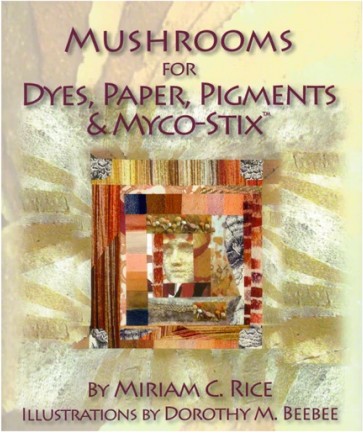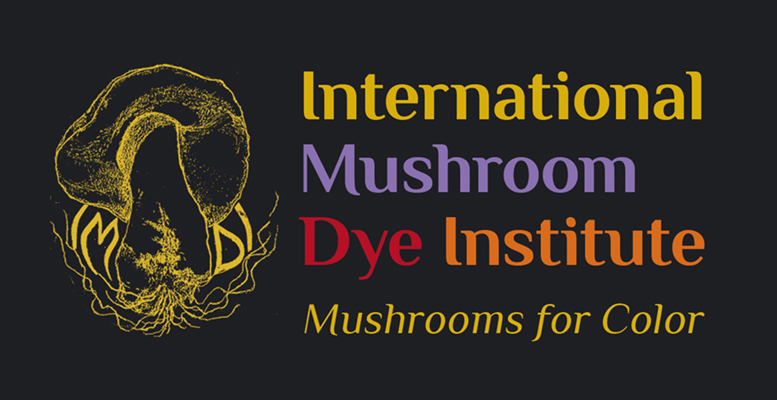by Julie Beeler

This book is the ultimate resource for anyone interested in exploring the chromatic universe of the fungi kingdom and the beautiful and subtle hues derived from working with mushrooms for color. Over a decade ago, when I first searched online to learn if mushrooms could be used for color, my search immediately returned Mushrooms for Dyes, Paper, Pigments & Myco-Stix as the top search result. I quickly ordered the book and immersed myself in it, with Miriam as my teacher, she guided me through the forest in search of dye mushrooms and into my studio as I worked to coax color from mushrooms.
Miriam Rice created the modern-day movement of working with mushrooms for color in the late 1960s. While teaching children’s art classes in Mendocino, California, she became curious about a bright yellow mushroom she had found (Hypholoma fasciculare, commonly known as sulfur tufts) and tossed a specimen into the dye pot with a bit of wool. Fortunately for all of us, her act resulted in a clear, bright lemon-yellow dye, inspiring her lifelong journey into extracting color from mushrooms.
Miriam documented and published her discoveries, which led to collaborations with Dorothy Beebee, Carla and Erik Sundstrom, and many other important mushroom dyers, researchers, and scientists. In 1980, they gathered at the first International Fungi & Fibre Symposium (a biennial event which continues to this day) to experiment with pigment-bearing mushrooms. In 2007, the International Mushroom Dye Institute (a non-profit organization that Miriam founded in 1985) published Mushrooms for Dyes, Paper, Pigments & Myco-Stix to celebrate Miriam’s 90th birthday at the 13th International Fungi & Fibre Symposium in Mendocino.
The book is organized into three main sections: Dyes, Paper, and Pigments & Myco-Stix. It is filled with exquisitely illustrated mushrooms by Dorothy Beebee. The beginning tells the brief history of Miriam’s work and how she, Dorothy, Carla and Erik all met, during the publication of Let’s Try Mushrooms for Color in 1974. The introduction immediately engages the reader with information on how to identify mushrooms and understand the anatomy, taxonomy and scientific names. From there the wondrous world of ‘dye’ mushrooms is presented, each organized by type with mycological information provided by Susan Libonati-Barnes, PhD, detailed illustrations by Dorothy Beebee along with Miriam’s identification notes.
After being immersed in the mycological world of dye mushrooms, readers are presented with an array of photographs showcasing the colors produced from these mushrooms, with glimpses into Miriam’s experiments. Miriam even shows how to record and document your own experimentations and walks through, in detail, the steps of how to prepare your fibers for dyeing, including working with various mordants that help the dyes bind to the fiber and improve their light- and washfastness. The dye section of the book is organized by color, charting each mushroom, and their associated colors. This list of dye fungi dating back to 1983, along with their location information, is a treasure trove for anyone curious about tracking historical taxonomic information and mapping it to today. The chemistry of mushroom dyes, provided by Eric Sundstrom, PhD, is a fascinating deep dive into the world of understanding the pigment compounds held within mushrooms.
Miriam’s explorations into the use of mushrooms for papermaking is comprehensive. She first explored making paper as a way to use the leftover mushroom fibers in exhausted dye baths. The beautiful samples are showcased with color photos and again, just as in the dyes section of the book, Miriam walks through, in detail, the steps on how to make paper using mushrooms. There is a comprehensive chart of each mushroom, its color, and texture to inform what type of paper it will create.
Finally we see all of Miriam’s work extracting pigments from mushrooms and transforming them into paint and Myco-Stix, a term she coined for her creation, which is similar to a crayon or charcoal but has a greater range of uses for oil painting, pastels or encaustic. Exactly like the other sections in the book she details in clear steps how to extract pigments, make watercolor paint, and create Myco-Stix for all their various uses from sketching to drawing to painting.
Miriam closes out the book talking about the future. Her dream “that those whose livelihoods are of the forest can, with their love of the woods, turn their attention away from felling trees, halt deforestation and, instead, grow mushrooms for pigments, dyes, and paper.” Recently, there has been a surge in the research of fungi colorants and their application to textiles. We have Miriam to thank for her life-long work researching, experimenting, documenting and most importantly sharing her infectious interest in mushrooms for color. With more scientists from diverse backgrounds now researching fungi, and as the study of mycology continues to develop with the discovery of new species, there is sure to be an explosion of possibilities, processes, and colorants from the fungi kingdom fueling Miriam’s dream into reality.
$36.95
Domestic orders from Fungi Perfecti
International orders from The Net Loft
Julie Beeler is a designer, artist, and educator with a deep love and curiosity for the natural world. She created the Mushroom Color Atlas to grow her work and passion to benefit what she values most: education, creativity, collaboration, community, and the environment. Her book about the Mushroom Color Atlas will be released by Chronicle Books in Fall 2024.
